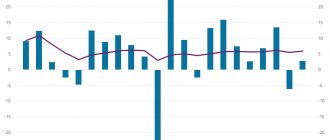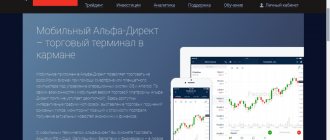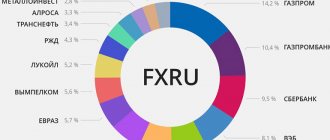The Stabilization Fund of Russia (SF RF) was organized to maintain a stable level of the economy in 2004. He acted as one of the key elements of the state budget.
The Northern Fleet of Russia was supposed to perform the following tasks:
- further strengthen the stability of the state’s finances;
- reduce inflation and balance the country’s budget if the price of oil falls below planned;
- finance the state pension system;
- contribute to reducing budget expenditures in subsequent periods by financing investment programs.
The idea of creating the Foundation was approved by everyone - the positive practice of the functioning of similar organizations in many countries around the world is proof of this. In fact, the state controlled these financial resources directly.
The Budget Code of the Russian Federation regulated how to form and use the Stabilization Fund's savings. The stabilization fund was the main instrument for containing financial volumes in the state economy, some of which remained for a rainy day.
At that time, the government had at its disposal enormous sums of money, which were released into circulation when the need arose. In fact, the Stabilization Fund played the role of the first sterilizer in the Russian economy, accumulating within itself a large share of excess funds.
Stabilization fund in the country's economy
The classic understanding of the term is the state’s financial reserve, which protects the economy from the Groningen effect – often also called Dutch disease.
In essence, the Groningen effect is nothing more than the negative impact that the strengthening of the real exchange rate has on the economic development of a country, which is a consequence of the boom in a particular sector.
Speaking, for example, about Russia, such an effect is observed in the event of a sharp decline in oil or gas prices, on which the formation of the country’s budget depends and which can vary arbitrarily over a wide range. The danger of the Groningen effect is difficult to overestimate; for example, it was one of the reasons for the collapse of the USSR, and later led to the 1998 crisis in the country.
The only “cure” for the Dutch disease was the Stabilization Fund, created in Russia in 2003, which was formed by deductions of all income above a certain price per barrel of oil - the cut-off price.
At the same time, such a fund did not cause much enthusiasm among the “masses”, constantly being criticized by both politicians and ordinary people. The main dissatisfaction of the critics was the fact that the money, in fact, lay dead weight, not being used in any way.
However, the crisis of 2008-2009 put everything in its place, allowing the state, using funds previously accumulated in the stabilization fund, to fulfill its social obligations during a difficult period for the economy.
Pensions and wages of state employees not only did not decrease, but were also subject to constant indexation, which, given the critical situation in which the state had a deficit budget and received virtually no income, already looked like a serious achievement.
What is this fund and what is it for?
This reserve fund is part of the social security mechanism for pensioners for many years. In Russia, the National Welfare Fund is replenished from excess revenues to the federal budget from the export of hydrocarbons. In fact, it is formed from budget money to control and stabilize the pension system and to financially support the funds that Russian citizens have saved for future pensions. The budget of the Pension Fund of the Russian Federation is being stabilized thanks to funds from the National Welfare Fund.
A certain share of the fund is represented in foreign currency for greater stability and is included in foreign Russian financial reserves. The other part finances national projects of the Russian government, which are unacceptable to be placed in foreign assets due to risk and the corresponding level of liquidity. Therefore, this fund is risky, but it can bring quite good returns.
Stabilization fund in business
One of the main tenets of business can be considered the statement that money must work. And it’s actually difficult to argue with this. The greater the company's turnover, the greater the profit it can count on.
On the other hand, there are companies whose work can be significantly complicated by negative factors. For example, enterprises involved in construction, medicine or tourism - that is, areas in which force majeure circumstances are quite possible, in which a stabilization fund is necessary.
The lack of a financial cushion can lead to the collapse of a company. There are quite a few high-profile brands that have once faced multimillion-dollar lawsuits or failure to fulfill the obligations of counterparties.
Thus, in the fall of 2016, the Moscow court satisfied the claim of Transaero against the tour operator Natalie Tours, “forcing” the latter to pay almost $6 million. never recovered, ceasing operations by September 2018 with debts of more than $18 million.
Despite the fact that the formation of a stabilization fund within a business is not particularly popular, it is wrong to ignore this issue, especially since modern investment instruments make it possible to transform the understanding of the classical scheme for forming a stabilization fund.
Financial structure
At the beginning of 2021, the volume of this fund amounted to 3,750 billion rubles (or about $65 billion at the average 2018 exchange rate), of which:
- In bank accounts: $15,000,000,000, 15 billion euros and about 3 billion pounds sterling.
- Vnesheconombank accounts – 220 billion rubles and $5 billion.
- About $3 billion in foreign debts that are paid by other Russian states.
- Securities of national infrastructure projects that were established by the Government of the country - more than 100 billion rubles and $3,000,000,000 in foreign currency.
- Preferred securities of lending organizations – about 220 billion rubles.
- Bank deposits for financing infrastructure projects (roads, bridges, railways) – 165 billion rubles.
Income from financial transactions with the fund's assets amounted to about 50 billion rubles in 2021. In 2021, revenue increased by 20 billion rubles. The government also admits the fact of a negative balance on financial transactions with the fund's assets.
Stabilization fund in the form of insurance
For small companies, a stabilization fund in its classical sense is a luxury, especially if the company is engaged, for example, in trading and its profitability depends entirely on the formation of working capital.
However, this does not mean that such a fund cannot appear from a different perspective. John Rockefeller once said: “Never skimp on advertising, security and insurance and your business will go uphill.” Disputing the statement of one of the largest financial tycoons in history is at least stupid. In light of the topic under consideration, the third factor that the businessman spoke about is important to us - insurance.
Despite the classical understanding of the stabilization fund as a “mountain of money” lying somewhere in the bins and waiting in the wings, modern methods allow us to “call” such a stabilization fund a good insurance with many additional options that will help the company correct its financial balance in difficult times.
That is, in this case, the stabilization fund is the insurance company, and in addition to the fact that this form will not be superfluous in a critical situation, it is an additional factor for confident entry into the market.
One of the young cleaning companies in Rostov-on-Don managed in a short time not only to gain large clients, but also to oust competitors through banal insurance, which provided for payments to the company’s clients in the event of damage to property by its employees.
Today this is standard practice, but in 2003 such options were rare in Russian insurance companies and were “created” specifically for the client. The cleaning manager paid more than half of the development budget for the certificate, subsequently never regretting it and presenting it at all negotiations.
Dynamics of the Fund since 2008
Data is given as of January 1 of each year.
- 2008 - $32.00 billion.
- 2009 - $89.01 billion.
- 2010 - $91.52 billion.
- 2011 - $90.50 billion.
- 2012 - $86.70 billion.
- 2013 - $88.48 billion.
- 2014 - $88.63 billion.
- 2015 - $74.05 billion.
- 2016 - $71.20 billion.
- 2017 - $72.41 billion.
- 2018 - $65.00 billion.
- 2019 - $58.00 billion (3.8 trillion rubles).
How the National Welfare Fund has changed
Stabilization fund in the form of highly liquid securities
Another form of stabilization fund, which does not imply “dead accumulation” of funds, can be considered highly liquid securities, the yield of which will not only save savings from inflation, but also make a profit.
One of the tools for forming such a fund could be coupon bonds, payments on which must occur within a clearly defined time frame. For example, securities are selected for the portfolio taking into account the fact that payments occur monthly in approximately equal amounts.
This strategy will allow you to have a certain amount in the stabilization fund every month, and in the event of negative developments, you can quickly “throw off” the bonds on the market at a price even lower than the purchase price. Because the difference between the purchase and sale prices will already be offset by the income received.
The same can be said about stocks. True, in this case it is hardly worth counting on the distribution of dividends, but careful play on the stock exchange with a certain part of the fund will allow you to generate a small profitability, while the bulk of the savings should be placed in highly liquid securities, for example, in shares from the list of blue chips.
A similar mechanism will work in the space of mutual investment funds, again with clearly calculated payment terms and the ability to quickly redeem shares. At the same time, the implementation of such a program through open mutual funds can be considered as protected from risks as possible. True, there will not be great profitability, but in this matter it is necessary to respect the priorities.
Placement of funds
Finance can be located in the following assets and foreign currency:
- Bonds of global companies.
- Debts of other states.
- Bank accounts of investment projects.
- Bank accounts of government organizations and companies, for example, with Vnesheconombank.
- Bank accounts and deposit balances with the Central Bank of the Russian Federation.
- Debt obligations of administrative entities in infrastructure investment projects created by the Russian Government.
The Government of Russia annually provides the State Duma and the Federation Council with a report on income and expenses that form the budget of the National Welfare Fund from oil exports. A quarterly report is provided on how other funds of the fund are generated and used.
What do bank reserves mean?
A reserve, in the generally accepted sense, is a reserve of financial resources, materials, products, and so on, for a specific case. Banks also have their own financial reserves.
What do they provide? Reliability of a specific financial structure. Moreover, not one reserve is created, but several, because losses can also be of various kinds . In what order to form this or that financial reserve and how to use it is prescribed in the legislative framework of the Russian Federation. The minimum size of each reserve is determined by the Central Bank of Russia.
Formation of a reserve fund of a commercial bank - calculation and norm
If there is a possibility of losses, then you need to assess the level of risk. This requires professional judgment and a specific risk classification.
It has five categories of quality of the counterparty’s financial condition:
- If there is no real or potential threat of non-fulfillment of obligations by the counterparty, the calculated reserve will be 0% (the calculated base of the element is taken as the base).
- If there is a threat of moderate-potential losses – 1-20%.
- If the potential threat of losses has a serious argument or in reality there is a moderate argument for losses (the counterparty’s financial situation has worsened) - 21-50%.
- Simultaneous presence of both potential and moderately real risks – 51-100%.
- There are all the facts indicating a loss in the value of a specific element , that is, the counterparty will not fulfill its obligations under the contract - 100%.
At the same time, the created reserve, or rather its total indicator, in fact must be in accordance with the indicator of expected losses.
Investment policy[edit]
Management structure[edit]
The Fund is managed by the Ministry of Finance of the Russian Federation in the manner determined by the Government of the Russian Federation. Some asset management functions may be transferred to the Central Bank of the Russian Federation (hereinafter referred to as the “Bank of Russia”) upon agreement with the Government.
In terms of the fund's objectives, its capital must be invested in foreign sovereign debt securities. The eligibility criteria for securities are approved by the Government.
The Government is authorized by the Ministry of Finance to determine the Fund's currency structure and its strategic asset allocation in accordance with the investment policy of the Fund's management.
The Ministry of Finance may use one or both of the following schemes, as determined by the Government, to invest the capital of the Fund.
| Schemes determined by the Government for investing the Fund's capital |
| Direct investment in eligible foreign fixed income securities |
| Deductions to the Federal Treasury accounts with the Bank of Russia in foreign currency with the total income on these accounts based on indices compiled from eligible external debt securities and determined by the Ministry of the Russian Federation. Finance. |
Currently, the fund's funds are invested exclusively according to the second scheme (placement in Federal Treasury accounts with the Bank of Russia).
Investment principles [edit]
The Government has determined that eligible debt securities for investment by the Fund must meet the following requirements.
| Fixed income securities of Austria, Belgium, Finland, France, Germany, Greece, Ireland, Italy, Luxembourg, Netherlands, Portugal, Spain, UK and US denominated in US dollars, euros, pounds sterling (sovereign debt securities) |
| The issuer must have a long-term credit rating of AAA/Aaa (the highest investment rating) from at least two of the three rating agencies: Moody's Investors Service, Standard and Poor's, Fitch Ratings. |
| Minimum amount of a candidate's deposit: US$1 billion, €1 billion, £500 million respectively |
| Securities should be a Bullet strategy |
| Securities must not have call or put options. |
| Fixed coupon type if coupon bond |
| Not for private placement |
The debt securities on the date of purchase will have a minimum remaining maturity of 0.25 years and will not exceed three years.
The fund's assets are currently invested in the following currency composition:
| U.S. dollars | 45% |
| Euro | 45% |
| Pounds | 10% |
Currency composition and maturity restrictions apply to all Fund assets and are subject to revision by the Department of the Treasury.











